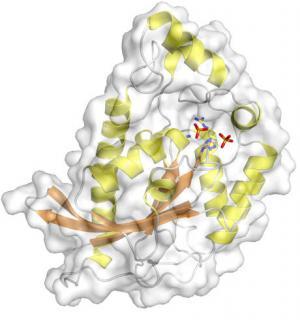
Two Brown University researchers have determined the three-dimensional structure of an enzyme whose presence in the body could help doctors detect cancer earlier or develop more targeted treatments.
Hua Li and Gerwald Jogl detail their progress with the enzyme known as TIGAR in a paper published Jan. 16, 2009 in The Journal of Biological Chemistry.
"It will help us to understand where else we should be looking for good [anti-cancer] targets," said Jogl, assistant professor of biology in the Department of Molecular Biology, Cell Biology and Biochemistry at Brown. Jogl is the study"s principal investigator and corresponding author. Li is a fifth-year Ph.D. student based in Jogl"s lab and is the lead author.
Jogl and Li wanted to determine the structure of TIGAR. After more than a year of research, they discovered that it is has a more substantive active site than they had expected. To map the structure, the pair used a method called X-ray crystallography.
The process involved using intensive X-ray light produced at the National Synchroton Light Source in Brookhaven, N.Y., to analyze crystals grown from samples of the TIGAR enzyme.
A separate study by researchers from St. Jude"s Children"s Research Hospital first identified the existence of TIGAR. Those results were published in CELL in 2006.
TIGAR, which helps regulate energy production in the cell, is activated after cell damage. Because of this, the presence of the enzyme can indicate potential problems that may lead to cancer. But TIGAR itself is positive. Once activated, TIGAR slows all processes in the cell, allowing time to repair cell damage. This process is also intended to prevent further damage that could lead to cancer.
Jogl and Li believe their finding may suggest that TIGAR has additional functions in the cell.
Understanding TIGAR is important, Jogl said, because the enzyme is "one of the good guys" in the battle against cancer. Because its presence can come in tandem with cellular damage, TIGAR is an important clue for scientists that could indicate cancer may follow. Knowing more about TIGAR could lead to earlier cancer detection or even preventative treatments.
"We are looking at the good guys," Jogl said. "Studying the good guys will lead us to the bad guys and where the places are to interfere."
A National Institutes of Health grant helped support the study.
Further Information:
Hua Li and Gerwald Jogl:
Structural and Biochemical Studies of TIGAR (TP53-induced Glycolysis and Apoptosis Regulator).
In: Journal of Biological Chemistry; Vol. 284, Issue 3, 1748-1754, January 16, 2009, DOI 10.1074/jbc.M807821200
Douglas R. Green and Jerry E. Chipuk:
p53 and Metabolism: Inside the TIGAR.
In: Cell; Volume 126, Issue 1, 30-32, 14 July 2006, DOI 10.1016/j.cell.2006.06.032
Source: Brown University, USA
Last update: 19.01.2009
Perma link: https://www.internetchemistry.com/news/2009/jan09/structure-of-tigar.php
More chemistry: index | chemicals | lab equipment | job vacancies | sitemap
Internetchemistry: home | about | contact | imprint | privacy
© 1996 - 2023 Internetchemistry
